Exploring Business Law: Business Structures and Shareholder Protection
VerifiedAdded on 2023/06/18
|11
|3560
|387
Report
AI Summary
This report provides an overview of key business law concepts for business managers. It discusses various types of business organizations, including sole proprietorships, partnerships, limited liability partnerships, and companies, outlining their advantages and disadvantages. It also examines the distinction between an offer to sell and an invitation to treat, referencing key cases like Harvey v. Facey and Fisher v. Bell to illustrate the principles. Furthermore, the report explains the remedies available to shareholders against the directors of a company, citing relevant legislation and case law to provide a comprehensive understanding of shareholder protection mechanisms. This document is available on Desklib, where students can find a wealth of study resources.

For Business
Managers
Managers
Paraphrase This Document
Need a fresh take? Get an instant paraphrase of this document with our AI Paraphraser
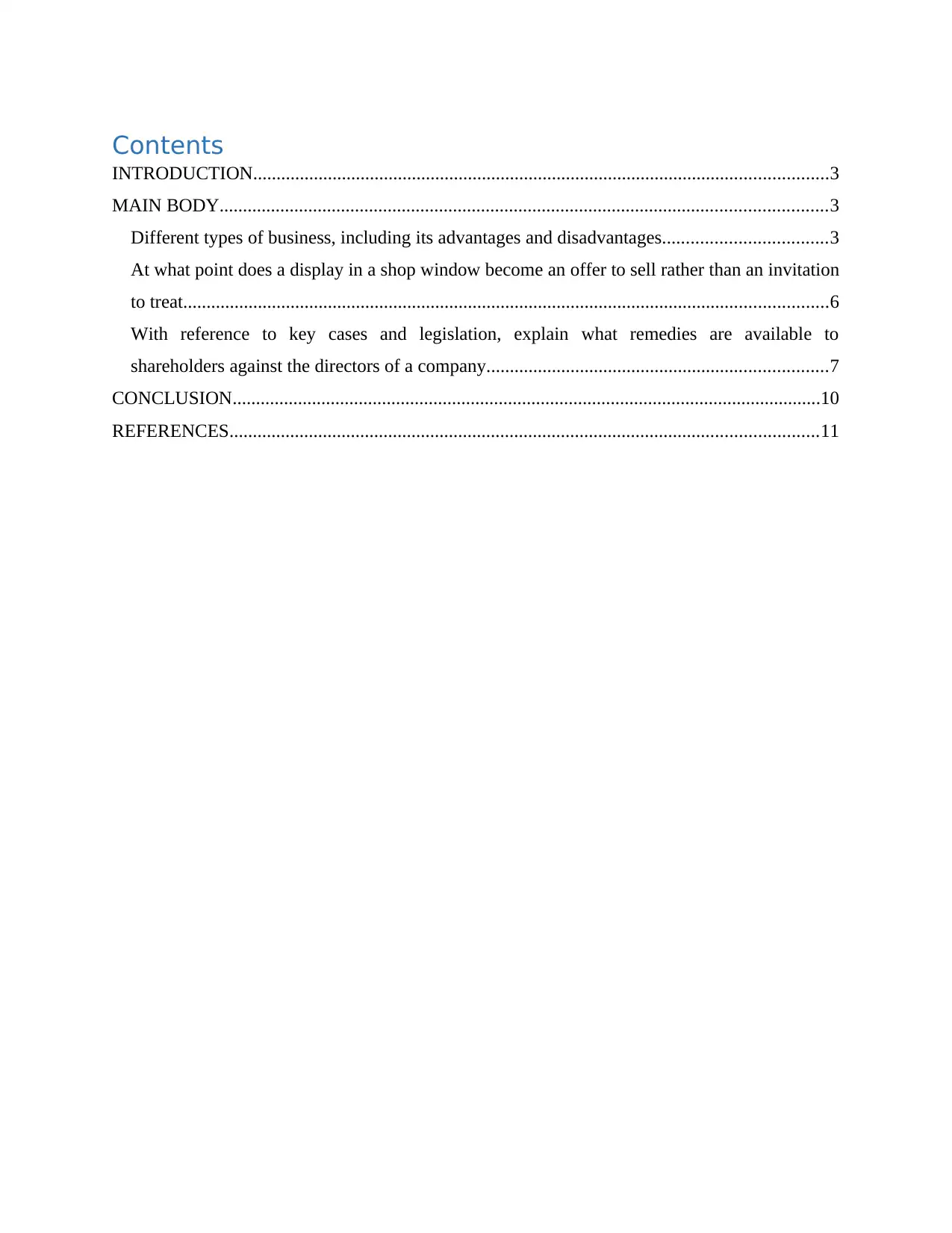
Contents
INTRODUCTION...........................................................................................................................3
MAIN BODY..................................................................................................................................3
Different types of business, including its advantages and disadvantages...................................3
At what point does a display in a shop window become an offer to sell rather than an invitation
to treat..........................................................................................................................................6
With reference to key cases and legislation, explain what remedies are available to
shareholders against the directors of a company.........................................................................7
CONCLUSION..............................................................................................................................10
REFERENCES..............................................................................................................................11
INTRODUCTION...........................................................................................................................3
MAIN BODY..................................................................................................................................3
Different types of business, including its advantages and disadvantages...................................3
At what point does a display in a shop window become an offer to sell rather than an invitation
to treat..........................................................................................................................................6
With reference to key cases and legislation, explain what remedies are available to
shareholders against the directors of a company.........................................................................7
CONCLUSION..............................................................................................................................10
REFERENCES..............................................................................................................................11
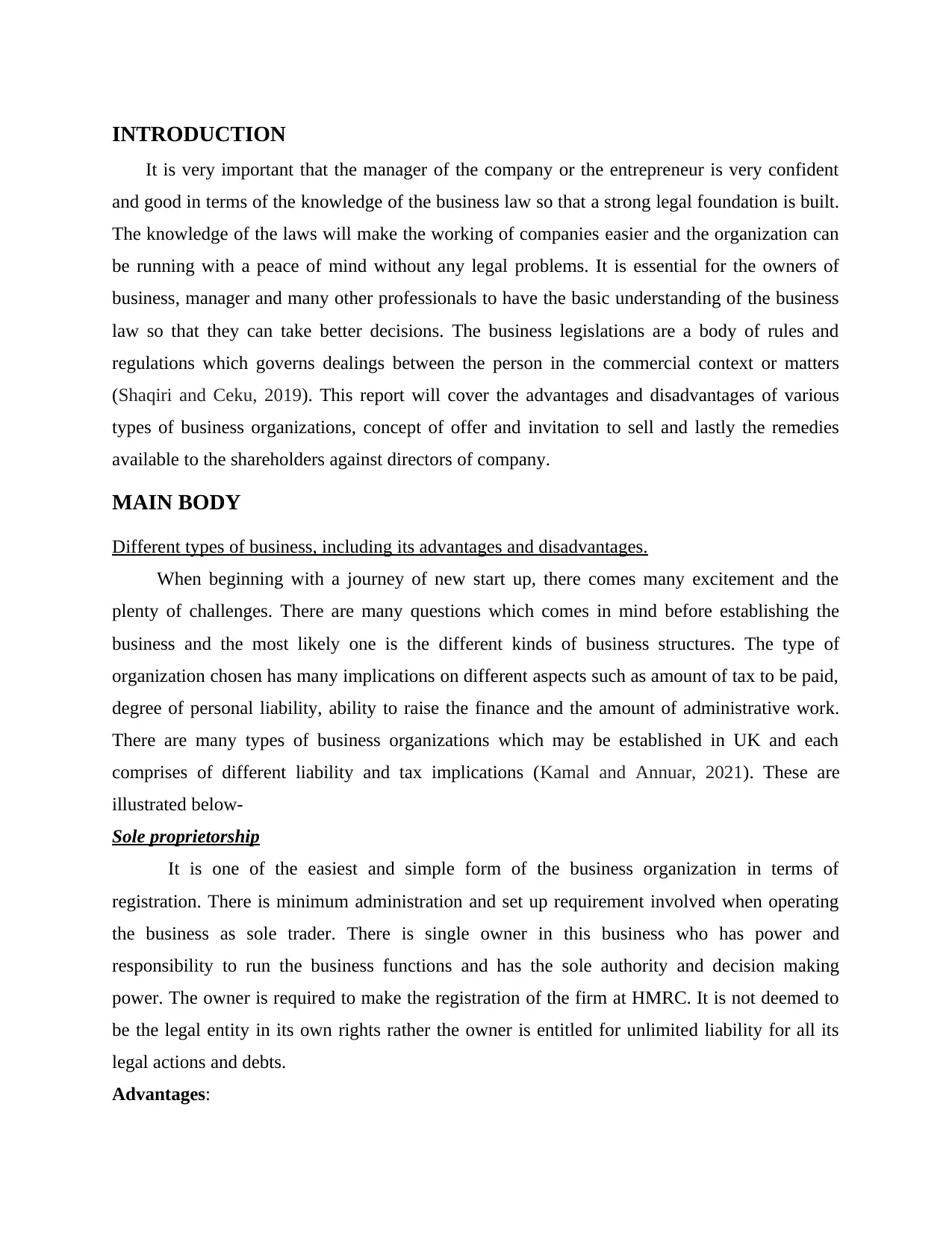
INTRODUCTION
It is very important that the manager of the company or the entrepreneur is very confident
and good in terms of the knowledge of the business law so that a strong legal foundation is built.
The knowledge of the laws will make the working of companies easier and the organization can
be running with a peace of mind without any legal problems. It is essential for the owners of
business, manager and many other professionals to have the basic understanding of the business
law so that they can take better decisions. The business legislations are a body of rules and
regulations which governs dealings between the person in the commercial context or matters
(Shaqiri and Ceku, 2019). This report will cover the advantages and disadvantages of various
types of business organizations, concept of offer and invitation to sell and lastly the remedies
available to the shareholders against directors of company.
MAIN BODY
Different types of business, including its advantages and disadvantages.
When beginning with a journey of new start up, there comes many excitement and the
plenty of challenges. There are many questions which comes in mind before establishing the
business and the most likely one is the different kinds of business structures. The type of
organization chosen has many implications on different aspects such as amount of tax to be paid,
degree of personal liability, ability to raise the finance and the amount of administrative work.
There are many types of business organizations which may be established in UK and each
comprises of different liability and tax implications (Kamal and Annuar, 2021). These are
illustrated below-
Sole proprietorship
It is one of the easiest and simple form of the business organization in terms of
registration. There is minimum administration and set up requirement involved when operating
the business as sole trader. There is single owner in this business who has power and
responsibility to run the business functions and has the sole authority and decision making
power. The owner is required to make the registration of the firm at HMRC. It is not deemed to
be the legal entity in its own rights rather the owner is entitled for unlimited liability for all its
legal actions and debts.
Advantages:
It is very important that the manager of the company or the entrepreneur is very confident
and good in terms of the knowledge of the business law so that a strong legal foundation is built.
The knowledge of the laws will make the working of companies easier and the organization can
be running with a peace of mind without any legal problems. It is essential for the owners of
business, manager and many other professionals to have the basic understanding of the business
law so that they can take better decisions. The business legislations are a body of rules and
regulations which governs dealings between the person in the commercial context or matters
(Shaqiri and Ceku, 2019). This report will cover the advantages and disadvantages of various
types of business organizations, concept of offer and invitation to sell and lastly the remedies
available to the shareholders against directors of company.
MAIN BODY
Different types of business, including its advantages and disadvantages.
When beginning with a journey of new start up, there comes many excitement and the
plenty of challenges. There are many questions which comes in mind before establishing the
business and the most likely one is the different kinds of business structures. The type of
organization chosen has many implications on different aspects such as amount of tax to be paid,
degree of personal liability, ability to raise the finance and the amount of administrative work.
There are many types of business organizations which may be established in UK and each
comprises of different liability and tax implications (Kamal and Annuar, 2021). These are
illustrated below-
Sole proprietorship
It is one of the easiest and simple form of the business organization in terms of
registration. There is minimum administration and set up requirement involved when operating
the business as sole trader. There is single owner in this business who has power and
responsibility to run the business functions and has the sole authority and decision making
power. The owner is required to make the registration of the firm at HMRC. It is not deemed to
be the legal entity in its own rights rather the owner is entitled for unlimited liability for all its
legal actions and debts.
Advantages:
⊘ This is a preview!⊘
Do you want full access?
Subscribe today to unlock all pages.

Trusted by 1+ million students worldwide
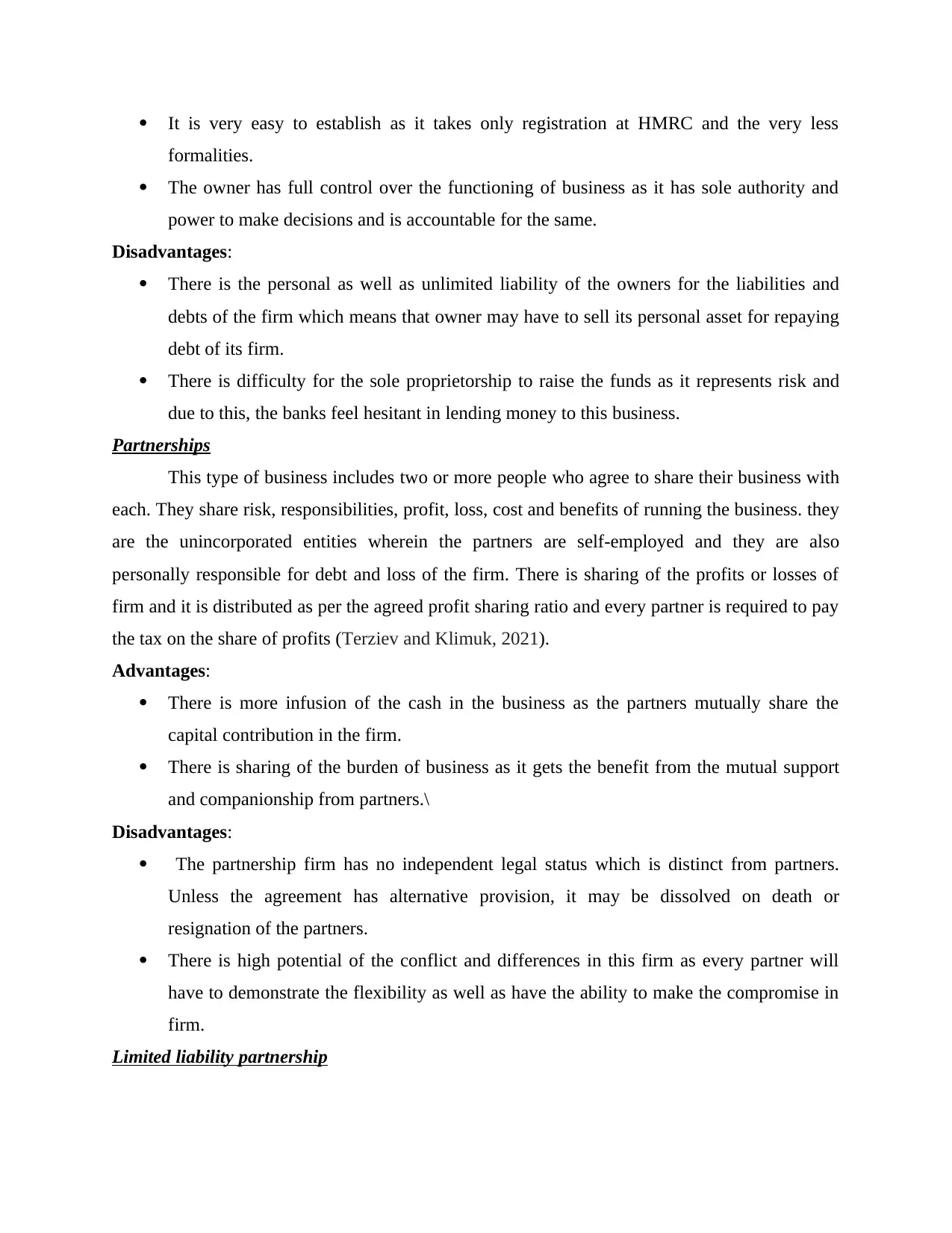
It is very easy to establish as it takes only registration at HMRC and the very less
formalities.
The owner has full control over the functioning of business as it has sole authority and
power to make decisions and is accountable for the same.
Disadvantages:
There is the personal as well as unlimited liability of the owners for the liabilities and
debts of the firm which means that owner may have to sell its personal asset for repaying
debt of its firm.
There is difficulty for the sole proprietorship to raise the funds as it represents risk and
due to this, the banks feel hesitant in lending money to this business.
Partnerships
This type of business includes two or more people who agree to share their business with
each. They share risk, responsibilities, profit, loss, cost and benefits of running the business. they
are the unincorporated entities wherein the partners are self-employed and they are also
personally responsible for debt and loss of the firm. There is sharing of the profits or losses of
firm and it is distributed as per the agreed profit sharing ratio and every partner is required to pay
the tax on the share of profits (Terziev and Klimuk, 2021).
Advantages:
There is more infusion of the cash in the business as the partners mutually share the
capital contribution in the firm.
There is sharing of the burden of business as it gets the benefit from the mutual support
and companionship from partners.\
Disadvantages:
The partnership firm has no independent legal status which is distinct from partners.
Unless the agreement has alternative provision, it may be dissolved on death or
resignation of the partners.
There is high potential of the conflict and differences in this firm as every partner will
have to demonstrate the flexibility as well as have the ability to make the compromise in
firm.
Limited liability partnership
formalities.
The owner has full control over the functioning of business as it has sole authority and
power to make decisions and is accountable for the same.
Disadvantages:
There is the personal as well as unlimited liability of the owners for the liabilities and
debts of the firm which means that owner may have to sell its personal asset for repaying
debt of its firm.
There is difficulty for the sole proprietorship to raise the funds as it represents risk and
due to this, the banks feel hesitant in lending money to this business.
Partnerships
This type of business includes two or more people who agree to share their business with
each. They share risk, responsibilities, profit, loss, cost and benefits of running the business. they
are the unincorporated entities wherein the partners are self-employed and they are also
personally responsible for debt and loss of the firm. There is sharing of the profits or losses of
firm and it is distributed as per the agreed profit sharing ratio and every partner is required to pay
the tax on the share of profits (Terziev and Klimuk, 2021).
Advantages:
There is more infusion of the cash in the business as the partners mutually share the
capital contribution in the firm.
There is sharing of the burden of business as it gets the benefit from the mutual support
and companionship from partners.\
Disadvantages:
The partnership firm has no independent legal status which is distinct from partners.
Unless the agreement has alternative provision, it may be dissolved on death or
resignation of the partners.
There is high potential of the conflict and differences in this firm as every partner will
have to demonstrate the flexibility as well as have the ability to make the compromise in
firm.
Limited liability partnership
Paraphrase This Document
Need a fresh take? Get an instant paraphrase of this document with our AI Paraphraser
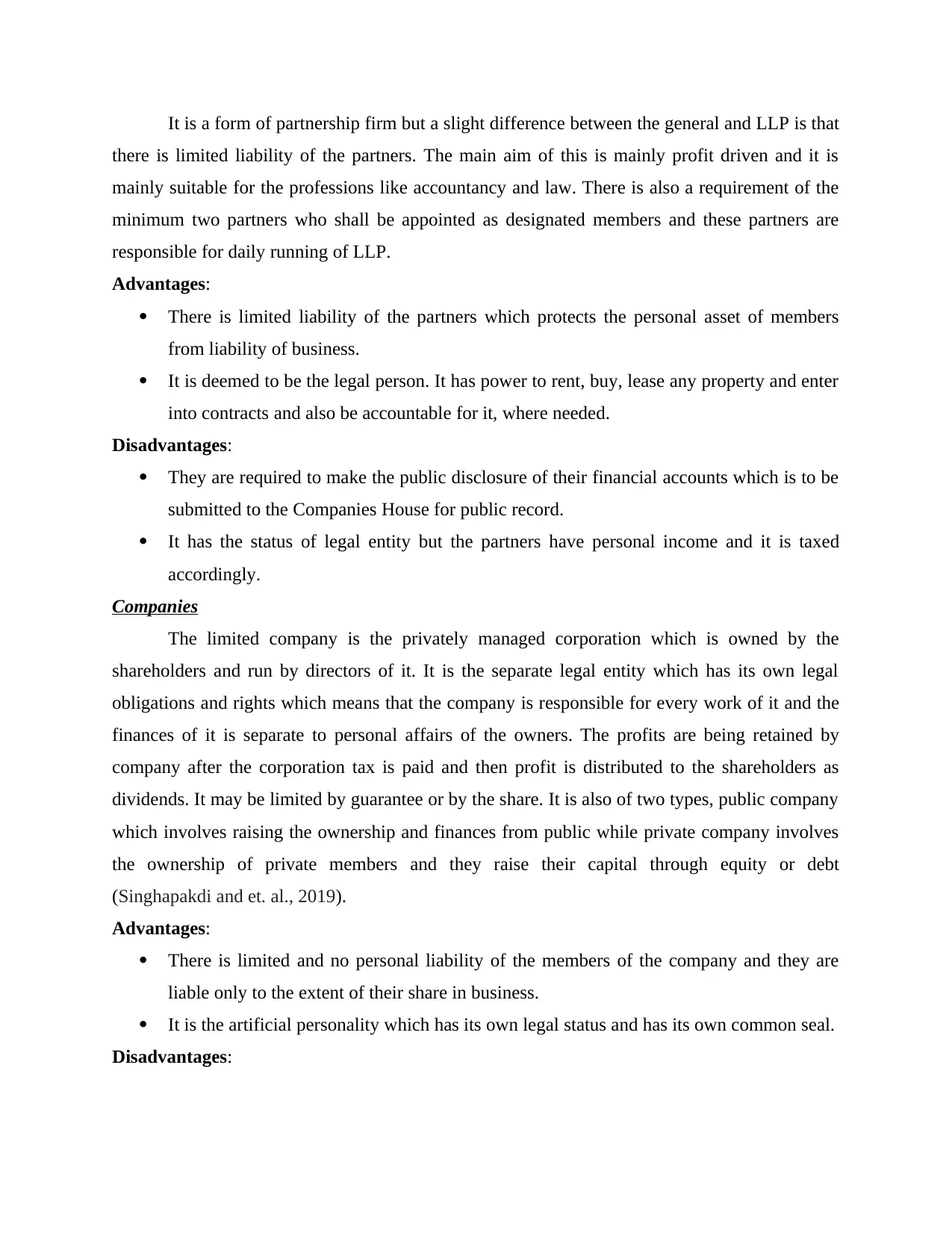
It is a form of partnership firm but a slight difference between the general and LLP is that
there is limited liability of the partners. The main aim of this is mainly profit driven and it is
mainly suitable for the professions like accountancy and law. There is also a requirement of the
minimum two partners who shall be appointed as designated members and these partners are
responsible for daily running of LLP.
Advantages:
There is limited liability of the partners which protects the personal asset of members
from liability of business.
It is deemed to be the legal person. It has power to rent, buy, lease any property and enter
into contracts and also be accountable for it, where needed.
Disadvantages:
They are required to make the public disclosure of their financial accounts which is to be
submitted to the Companies House for public record.
It has the status of legal entity but the partners have personal income and it is taxed
accordingly.
Companies
The limited company is the privately managed corporation which is owned by the
shareholders and run by directors of it. It is the separate legal entity which has its own legal
obligations and rights which means that the company is responsible for every work of it and the
finances of it is separate to personal affairs of the owners. The profits are being retained by
company after the corporation tax is paid and then profit is distributed to the shareholders as
dividends. It may be limited by guarantee or by the share. It is also of two types, public company
which involves raising the ownership and finances from public while private company involves
the ownership of private members and they raise their capital through equity or debt
(Singhapakdi and et. al., 2019).
Advantages:
There is limited and no personal liability of the members of the company and they are
liable only to the extent of their share in business.
It is the artificial personality which has its own legal status and has its own common seal.
Disadvantages:
there is limited liability of the partners. The main aim of this is mainly profit driven and it is
mainly suitable for the professions like accountancy and law. There is also a requirement of the
minimum two partners who shall be appointed as designated members and these partners are
responsible for daily running of LLP.
Advantages:
There is limited liability of the partners which protects the personal asset of members
from liability of business.
It is deemed to be the legal person. It has power to rent, buy, lease any property and enter
into contracts and also be accountable for it, where needed.
Disadvantages:
They are required to make the public disclosure of their financial accounts which is to be
submitted to the Companies House for public record.
It has the status of legal entity but the partners have personal income and it is taxed
accordingly.
Companies
The limited company is the privately managed corporation which is owned by the
shareholders and run by directors of it. It is the separate legal entity which has its own legal
obligations and rights which means that the company is responsible for every work of it and the
finances of it is separate to personal affairs of the owners. The profits are being retained by
company after the corporation tax is paid and then profit is distributed to the shareholders as
dividends. It may be limited by guarantee or by the share. It is also of two types, public company
which involves raising the ownership and finances from public while private company involves
the ownership of private members and they raise their capital through equity or debt
(Singhapakdi and et. al., 2019).
Advantages:
There is limited and no personal liability of the members of the company and they are
liable only to the extent of their share in business.
It is the artificial personality which has its own legal status and has its own common seal.
Disadvantages:
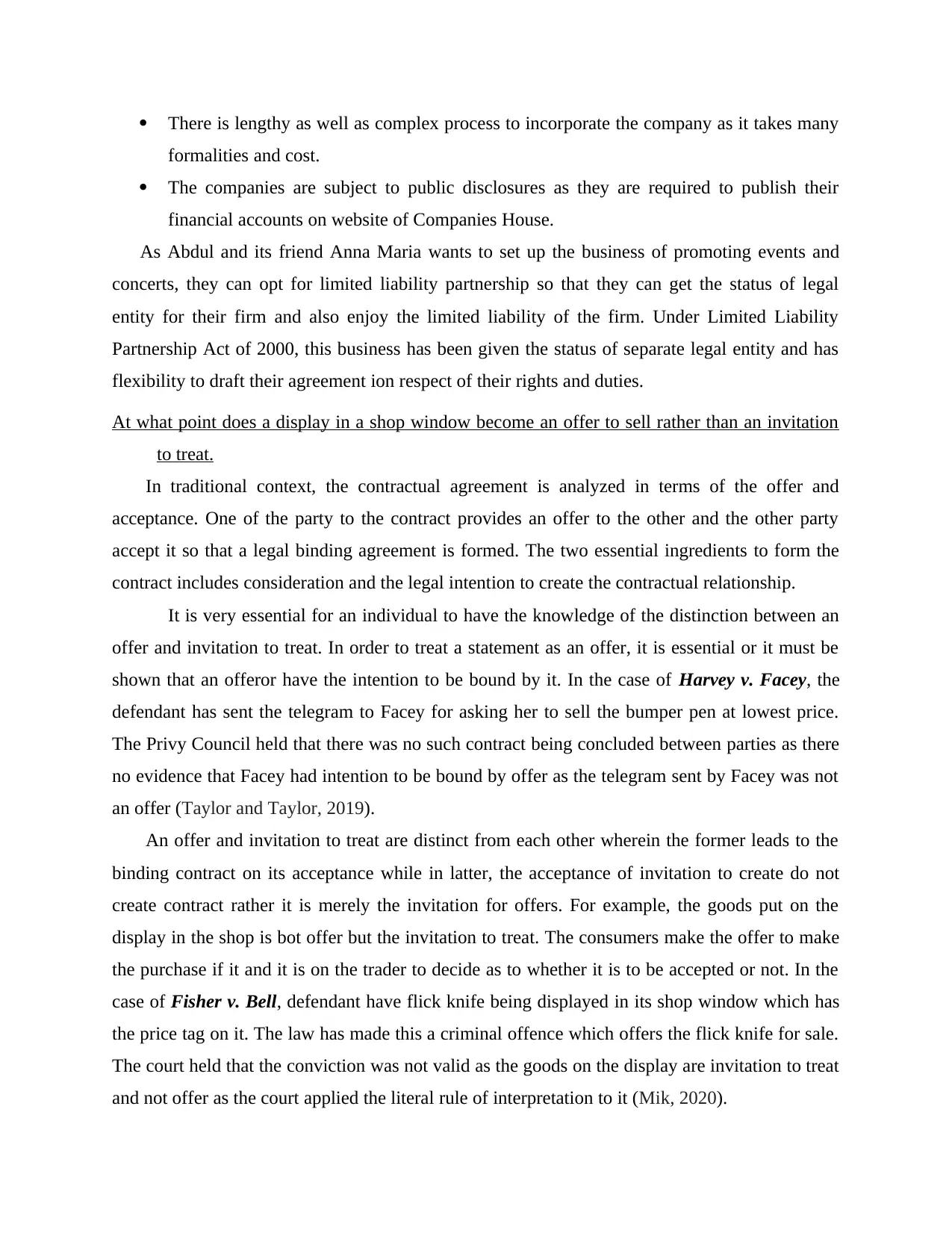
There is lengthy as well as complex process to incorporate the company as it takes many
formalities and cost.
The companies are subject to public disclosures as they are required to publish their
financial accounts on website of Companies House.
As Abdul and its friend Anna Maria wants to set up the business of promoting events and
concerts, they can opt for limited liability partnership so that they can get the status of legal
entity for their firm and also enjoy the limited liability of the firm. Under Limited Liability
Partnership Act of 2000, this business has been given the status of separate legal entity and has
flexibility to draft their agreement ion respect of their rights and duties.
At what point does a display in a shop window become an offer to sell rather than an invitation
to treat.
In traditional context, the contractual agreement is analyzed in terms of the offer and
acceptance. One of the party to the contract provides an offer to the other and the other party
accept it so that a legal binding agreement is formed. The two essential ingredients to form the
contract includes consideration and the legal intention to create the contractual relationship.
It is very essential for an individual to have the knowledge of the distinction between an
offer and invitation to treat. In order to treat a statement as an offer, it is essential or it must be
shown that an offeror have the intention to be bound by it. In the case of Harvey v. Facey, the
defendant has sent the telegram to Facey for asking her to sell the bumper pen at lowest price.
The Privy Council held that there was no such contract being concluded between parties as there
no evidence that Facey had intention to be bound by offer as the telegram sent by Facey was not
an offer (Taylor and Taylor, 2019).
An offer and invitation to treat are distinct from each other wherein the former leads to the
binding contract on its acceptance while in latter, the acceptance of invitation to create do not
create contract rather it is merely the invitation for offers. For example, the goods put on the
display in the shop is bot offer but the invitation to treat. The consumers make the offer to make
the purchase if it and it is on the trader to decide as to whether it is to be accepted or not. In the
case of Fisher v. Bell, defendant have flick knife being displayed in its shop window which has
the price tag on it. The law has made this a criminal offence which offers the flick knife for sale.
The court held that the conviction was not valid as the goods on the display are invitation to treat
and not offer as the court applied the literal rule of interpretation to it (Mik, 2020).
formalities and cost.
The companies are subject to public disclosures as they are required to publish their
financial accounts on website of Companies House.
As Abdul and its friend Anna Maria wants to set up the business of promoting events and
concerts, they can opt for limited liability partnership so that they can get the status of legal
entity for their firm and also enjoy the limited liability of the firm. Under Limited Liability
Partnership Act of 2000, this business has been given the status of separate legal entity and has
flexibility to draft their agreement ion respect of their rights and duties.
At what point does a display in a shop window become an offer to sell rather than an invitation
to treat.
In traditional context, the contractual agreement is analyzed in terms of the offer and
acceptance. One of the party to the contract provides an offer to the other and the other party
accept it so that a legal binding agreement is formed. The two essential ingredients to form the
contract includes consideration and the legal intention to create the contractual relationship.
It is very essential for an individual to have the knowledge of the distinction between an
offer and invitation to treat. In order to treat a statement as an offer, it is essential or it must be
shown that an offeror have the intention to be bound by it. In the case of Harvey v. Facey, the
defendant has sent the telegram to Facey for asking her to sell the bumper pen at lowest price.
The Privy Council held that there was no such contract being concluded between parties as there
no evidence that Facey had intention to be bound by offer as the telegram sent by Facey was not
an offer (Taylor and Taylor, 2019).
An offer and invitation to treat are distinct from each other wherein the former leads to the
binding contract on its acceptance while in latter, the acceptance of invitation to create do not
create contract rather it is merely the invitation for offers. For example, the goods put on the
display in the shop is bot offer but the invitation to treat. The consumers make the offer to make
the purchase if it and it is on the trader to decide as to whether it is to be accepted or not. In the
case of Fisher v. Bell, defendant have flick knife being displayed in its shop window which has
the price tag on it. The law has made this a criminal offence which offers the flick knife for sale.
The court held that the conviction was not valid as the goods on the display are invitation to treat
and not offer as the court applied the literal rule of interpretation to it (Mik, 2020).
⊘ This is a preview!⊘
Do you want full access?
Subscribe today to unlock all pages.

Trusted by 1+ million students worldwide
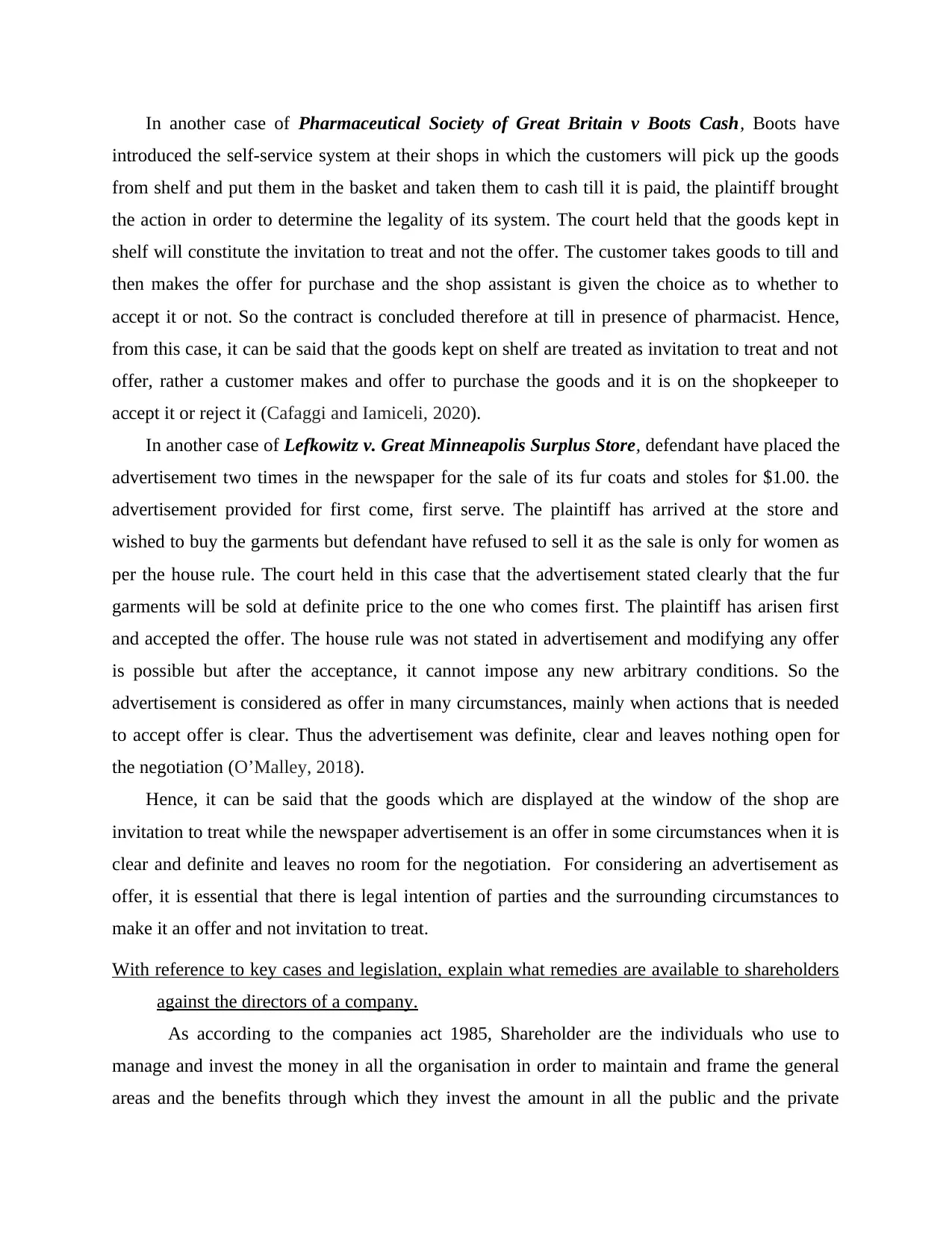
In another case of Pharmaceutical Society of Great Britain v Boots Cash, Boots have
introduced the self-service system at their shops in which the customers will pick up the goods
from shelf and put them in the basket and taken them to cash till it is paid, the plaintiff brought
the action in order to determine the legality of its system. The court held that the goods kept in
shelf will constitute the invitation to treat and not the offer. The customer takes goods to till and
then makes the offer for purchase and the shop assistant is given the choice as to whether to
accept it or not. So the contract is concluded therefore at till in presence of pharmacist. Hence,
from this case, it can be said that the goods kept on shelf are treated as invitation to treat and not
offer, rather a customer makes and offer to purchase the goods and it is on the shopkeeper to
accept it or reject it (Cafaggi and Iamiceli, 2020).
In another case of Lefkowitz v. Great Minneapolis Surplus Store, defendant have placed the
advertisement two times in the newspaper for the sale of its fur coats and stoles for $1.00. the
advertisement provided for first come, first serve. The plaintiff has arrived at the store and
wished to buy the garments but defendant have refused to sell it as the sale is only for women as
per the house rule. The court held in this case that the advertisement stated clearly that the fur
garments will be sold at definite price to the one who comes first. The plaintiff has arisen first
and accepted the offer. The house rule was not stated in advertisement and modifying any offer
is possible but after the acceptance, it cannot impose any new arbitrary conditions. So the
advertisement is considered as offer in many circumstances, mainly when actions that is needed
to accept offer is clear. Thus the advertisement was definite, clear and leaves nothing open for
the negotiation (O’Malley, 2018).
Hence, it can be said that the goods which are displayed at the window of the shop are
invitation to treat while the newspaper advertisement is an offer in some circumstances when it is
clear and definite and leaves no room for the negotiation. For considering an advertisement as
offer, it is essential that there is legal intention of parties and the surrounding circumstances to
make it an offer and not invitation to treat.
With reference to key cases and legislation, explain what remedies are available to shareholders
against the directors of a company.
As according to the companies act 1985, Shareholder are the individuals who use to
manage and invest the money in all the organisation in order to maintain and frame the general
areas and the benefits through which they invest the amount in all the public and the private
introduced the self-service system at their shops in which the customers will pick up the goods
from shelf and put them in the basket and taken them to cash till it is paid, the plaintiff brought
the action in order to determine the legality of its system. The court held that the goods kept in
shelf will constitute the invitation to treat and not the offer. The customer takes goods to till and
then makes the offer for purchase and the shop assistant is given the choice as to whether to
accept it or not. So the contract is concluded therefore at till in presence of pharmacist. Hence,
from this case, it can be said that the goods kept on shelf are treated as invitation to treat and not
offer, rather a customer makes and offer to purchase the goods and it is on the shopkeeper to
accept it or reject it (Cafaggi and Iamiceli, 2020).
In another case of Lefkowitz v. Great Minneapolis Surplus Store, defendant have placed the
advertisement two times in the newspaper for the sale of its fur coats and stoles for $1.00. the
advertisement provided for first come, first serve. The plaintiff has arrived at the store and
wished to buy the garments but defendant have refused to sell it as the sale is only for women as
per the house rule. The court held in this case that the advertisement stated clearly that the fur
garments will be sold at definite price to the one who comes first. The plaintiff has arisen first
and accepted the offer. The house rule was not stated in advertisement and modifying any offer
is possible but after the acceptance, it cannot impose any new arbitrary conditions. So the
advertisement is considered as offer in many circumstances, mainly when actions that is needed
to accept offer is clear. Thus the advertisement was definite, clear and leaves nothing open for
the negotiation (O’Malley, 2018).
Hence, it can be said that the goods which are displayed at the window of the shop are
invitation to treat while the newspaper advertisement is an offer in some circumstances when it is
clear and definite and leaves no room for the negotiation. For considering an advertisement as
offer, it is essential that there is legal intention of parties and the surrounding circumstances to
make it an offer and not invitation to treat.
With reference to key cases and legislation, explain what remedies are available to shareholders
against the directors of a company.
As according to the companies act 1985, Shareholder are the individuals who use to
manage and invest the money in all the organisation in order to maintain and frame the general
areas and the benefits through which they invest the amount in all the public and the private
Paraphrase This Document
Need a fresh take? Get an instant paraphrase of this document with our AI Paraphraser
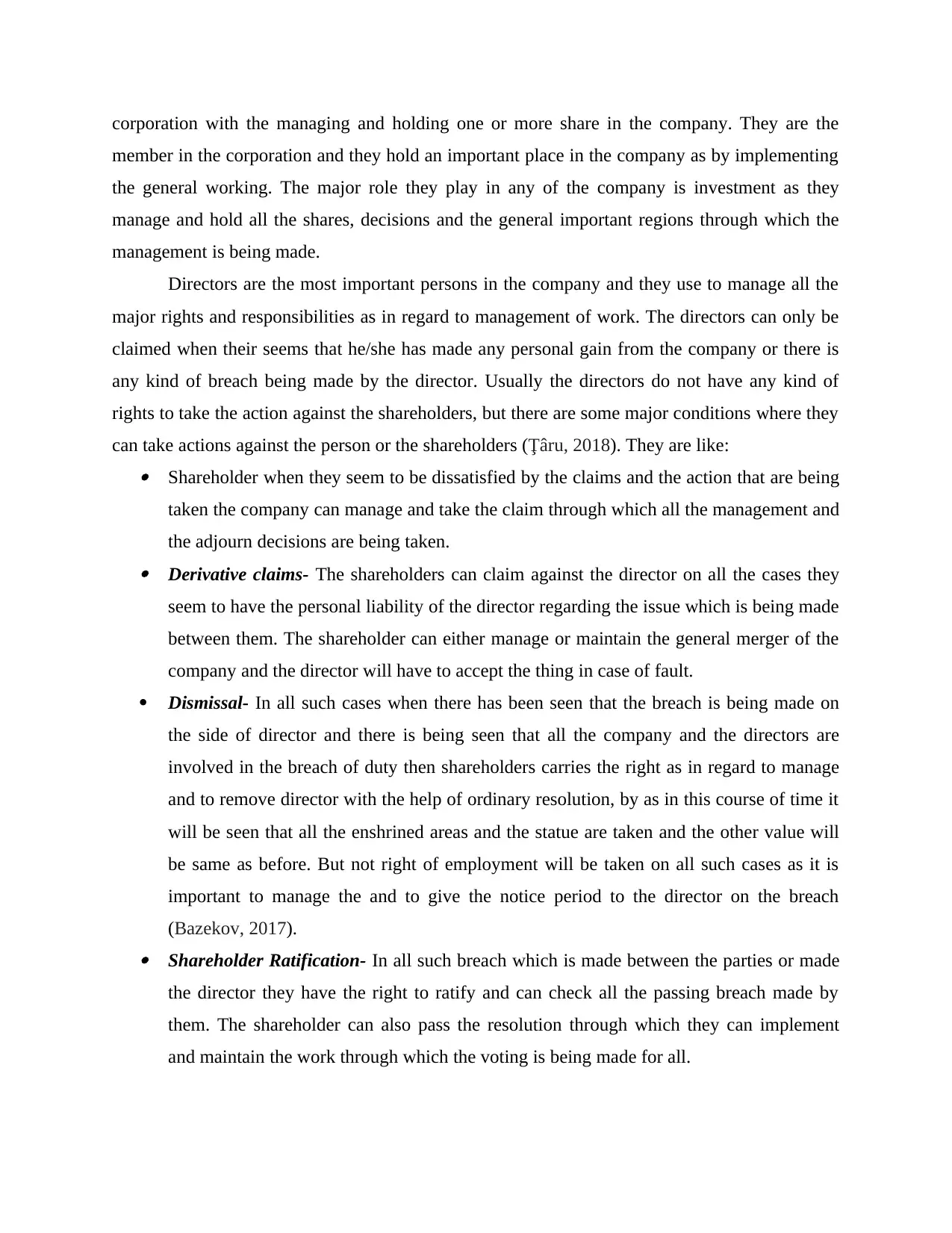
corporation with the managing and holding one or more share in the company. They are the
member in the corporation and they hold an important place in the company as by implementing
the general working. The major role they play in any of the company is investment as they
manage and hold all the shares, decisions and the general important regions through which the
management is being made.
Directors are the most important persons in the company and they use to manage all the
major rights and responsibilities as in regard to management of work. The directors can only be
claimed when their seems that he/she has made any personal gain from the company or there is
any kind of breach being made by the director. Usually the directors do not have any kind of
rights to take the action against the shareholders, but there are some major conditions where they
can take actions against the person or the shareholders (Ţâru, 2018). They are like: Shareholder when they seem to be dissatisfied by the claims and the action that are being
taken the company can manage and take the claim through which all the management and
the adjourn decisions are being taken. Derivative claims- The shareholders can claim against the director on all the cases they
seem to have the personal liability of the director regarding the issue which is being made
between them. The shareholder can either manage or maintain the general merger of the
company and the director will have to accept the thing in case of fault.
Dismissal- In all such cases when there has been seen that the breach is being made on
the side of director and there is being seen that all the company and the directors are
involved in the breach of duty then shareholders carries the right as in regard to manage
and to remove director with the help of ordinary resolution, by as in this course of time it
will be seen that all the enshrined areas and the statue are taken and the other value will
be same as before. But not right of employment will be taken on all such cases as it is
important to manage the and to give the notice period to the director on the breach
(Bazekov, 2017). Shareholder Ratification- In all such breach which is made between the parties or made
the director they have the right to ratify and can check all the passing breach made by
them. The shareholder can also pass the resolution through which they can implement
and maintain the work through which the voting is being made for all.
member in the corporation and they hold an important place in the company as by implementing
the general working. The major role they play in any of the company is investment as they
manage and hold all the shares, decisions and the general important regions through which the
management is being made.
Directors are the most important persons in the company and they use to manage all the
major rights and responsibilities as in regard to management of work. The directors can only be
claimed when their seems that he/she has made any personal gain from the company or there is
any kind of breach being made by the director. Usually the directors do not have any kind of
rights to take the action against the shareholders, but there are some major conditions where they
can take actions against the person or the shareholders (Ţâru, 2018). They are like: Shareholder when they seem to be dissatisfied by the claims and the action that are being
taken the company can manage and take the claim through which all the management and
the adjourn decisions are being taken. Derivative claims- The shareholders can claim against the director on all the cases they
seem to have the personal liability of the director regarding the issue which is being made
between them. The shareholder can either manage or maintain the general merger of the
company and the director will have to accept the thing in case of fault.
Dismissal- In all such cases when there has been seen that the breach is being made on
the side of director and there is being seen that all the company and the directors are
involved in the breach of duty then shareholders carries the right as in regard to manage
and to remove director with the help of ordinary resolution, by as in this course of time it
will be seen that all the enshrined areas and the statue are taken and the other value will
be same as before. But not right of employment will be taken on all such cases as it is
important to manage the and to give the notice period to the director on the breach
(Bazekov, 2017). Shareholder Ratification- In all such breach which is made between the parties or made
the director they have the right to ratify and can check all the passing breach made by
them. The shareholder can also pass the resolution through which they can implement
and maintain the work through which the voting is being made for all.
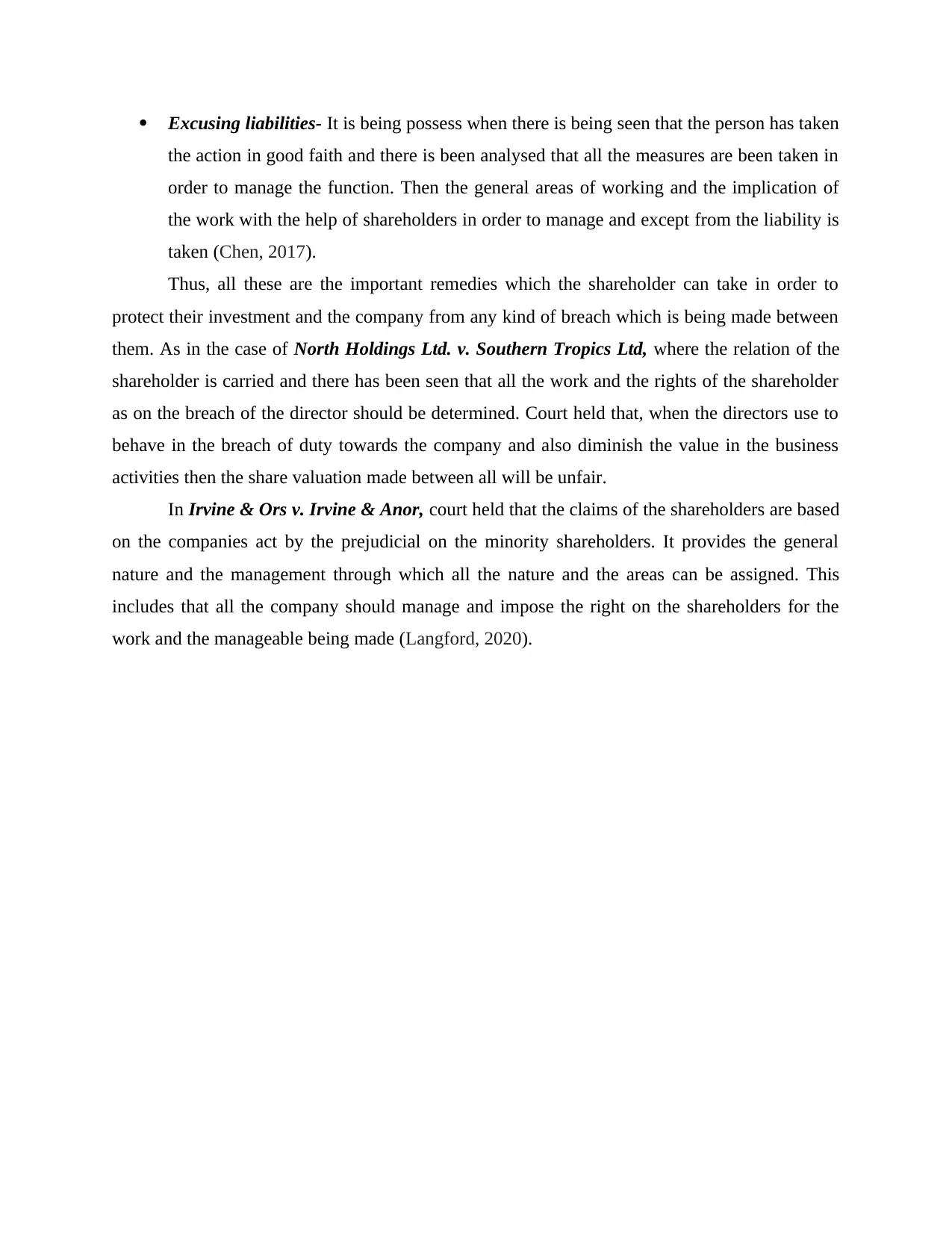
Excusing liabilities- It is being possess when there is being seen that the person has taken
the action in good faith and there is been analysed that all the measures are been taken in
order to manage the function. Then the general areas of working and the implication of
the work with the help of shareholders in order to manage and except from the liability is
taken (Chen, 2017).
Thus, all these are the important remedies which the shareholder can take in order to
protect their investment and the company from any kind of breach which is being made between
them. As in the case of North Holdings Ltd. v. Southern Tropics Ltd, where the relation of the
shareholder is carried and there has been seen that all the work and the rights of the shareholder
as on the breach of the director should be determined. Court held that, when the directors use to
behave in the breach of duty towards the company and also diminish the value in the business
activities then the share valuation made between all will be unfair.
In Irvine & Ors v. Irvine & Anor, court held that the claims of the shareholders are based
on the companies act by the prejudicial on the minority shareholders. It provides the general
nature and the management through which all the nature and the areas can be assigned. This
includes that all the company should manage and impose the right on the shareholders for the
work and the manageable being made (Langford, 2020).
the action in good faith and there is been analysed that all the measures are been taken in
order to manage the function. Then the general areas of working and the implication of
the work with the help of shareholders in order to manage and except from the liability is
taken (Chen, 2017).
Thus, all these are the important remedies which the shareholder can take in order to
protect their investment and the company from any kind of breach which is being made between
them. As in the case of North Holdings Ltd. v. Southern Tropics Ltd, where the relation of the
shareholder is carried and there has been seen that all the work and the rights of the shareholder
as on the breach of the director should be determined. Court held that, when the directors use to
behave in the breach of duty towards the company and also diminish the value in the business
activities then the share valuation made between all will be unfair.
In Irvine & Ors v. Irvine & Anor, court held that the claims of the shareholders are based
on the companies act by the prejudicial on the minority shareholders. It provides the general
nature and the management through which all the nature and the areas can be assigned. This
includes that all the company should manage and impose the right on the shareholders for the
work and the manageable being made (Langford, 2020).
⊘ This is a preview!⊘
Do you want full access?
Subscribe today to unlock all pages.

Trusted by 1+ million students worldwide
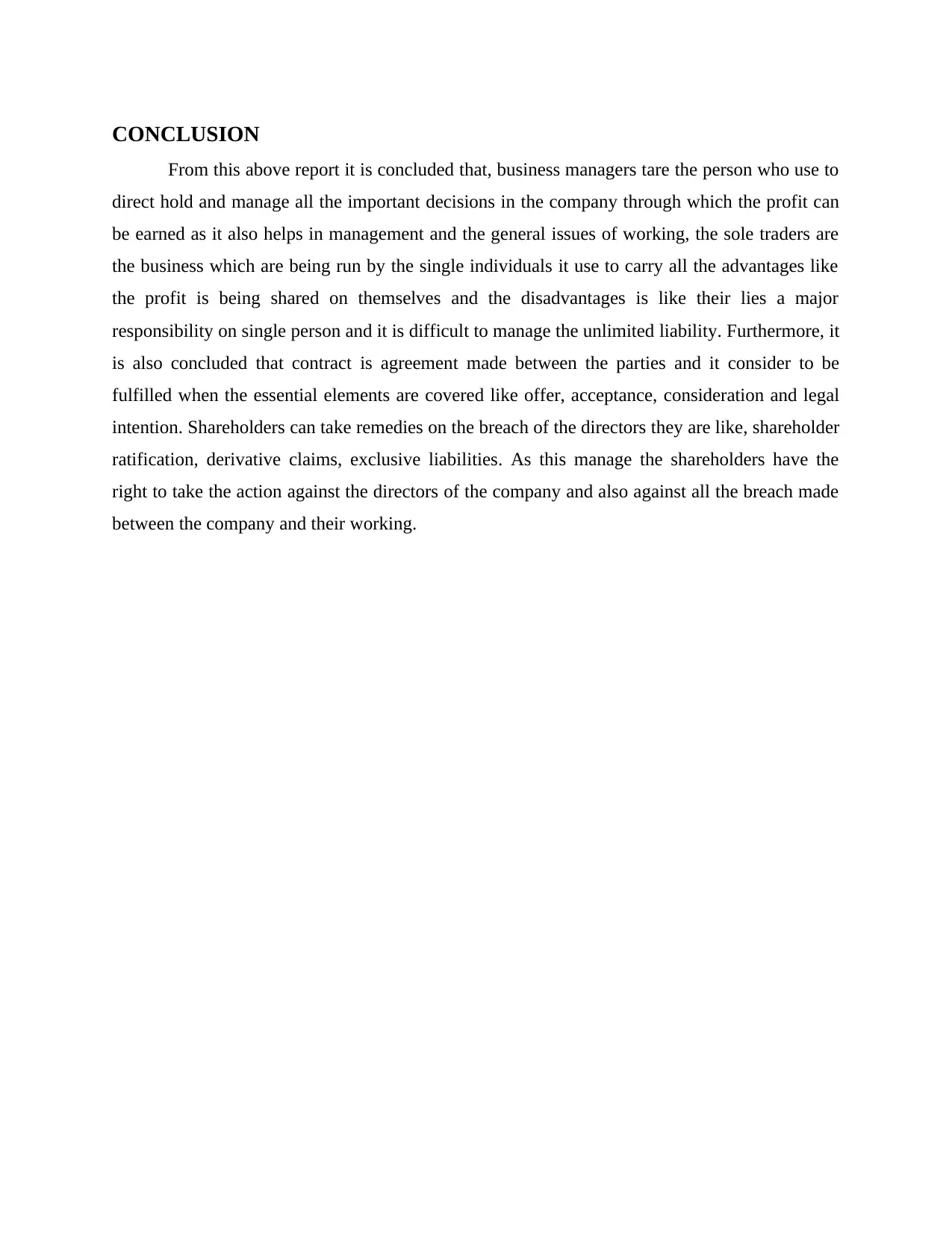
CONCLUSION
From this above report it is concluded that, business managers tare the person who use to
direct hold and manage all the important decisions in the company through which the profit can
be earned as it also helps in management and the general issues of working, the sole traders are
the business which are being run by the single individuals it use to carry all the advantages like
the profit is being shared on themselves and the disadvantages is like their lies a major
responsibility on single person and it is difficult to manage the unlimited liability. Furthermore, it
is also concluded that contract is agreement made between the parties and it consider to be
fulfilled when the essential elements are covered like offer, acceptance, consideration and legal
intention. Shareholders can take remedies on the breach of the directors they are like, shareholder
ratification, derivative claims, exclusive liabilities. As this manage the shareholders have the
right to take the action against the directors of the company and also against all the breach made
between the company and their working.
From this above report it is concluded that, business managers tare the person who use to
direct hold and manage all the important decisions in the company through which the profit can
be earned as it also helps in management and the general issues of working, the sole traders are
the business which are being run by the single individuals it use to carry all the advantages like
the profit is being shared on themselves and the disadvantages is like their lies a major
responsibility on single person and it is difficult to manage the unlimited liability. Furthermore, it
is also concluded that contract is agreement made between the parties and it consider to be
fulfilled when the essential elements are covered like offer, acceptance, consideration and legal
intention. Shareholders can take remedies on the breach of the directors they are like, shareholder
ratification, derivative claims, exclusive liabilities. As this manage the shareholders have the
right to take the action against the directors of the company and also against all the breach made
between the company and their working.
Paraphrase This Document
Need a fresh take? Get an instant paraphrase of this document with our AI Paraphraser
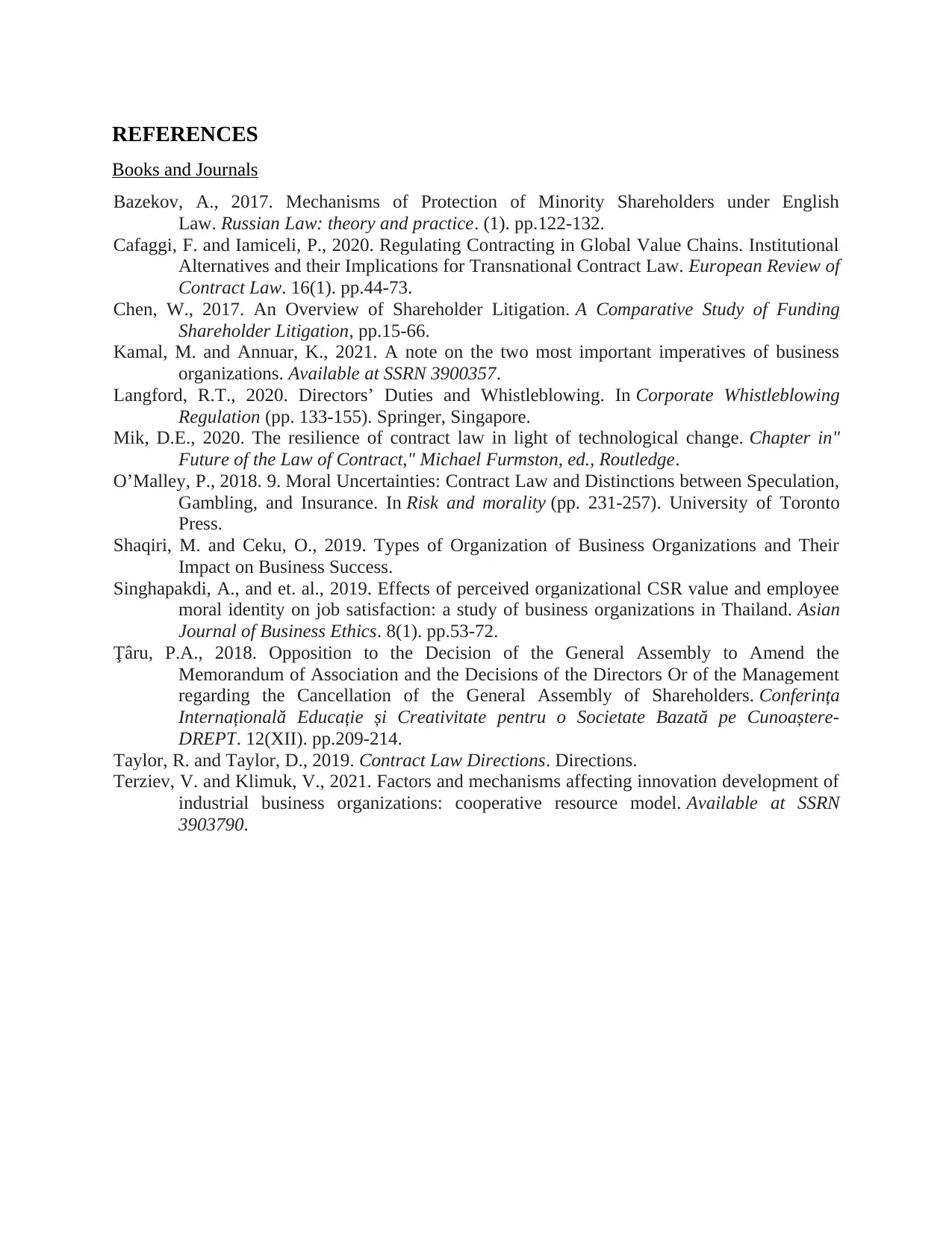
REFERENCES
Books and Journals
Bazekov, A., 2017. Mechanisms of Protection of Minority Shareholders under English
Law. Russian Law: theory and practice. (1). pp.122-132.
Cafaggi, F. and Iamiceli, P., 2020. Regulating Contracting in Global Value Chains. Institutional
Alternatives and their Implications for Transnational Contract Law. European Review of
Contract Law. 16(1). pp.44-73.
Chen, W., 2017. An Overview of Shareholder Litigation. A Comparative Study of Funding
Shareholder Litigation, pp.15-66.
Kamal, M. and Annuar, K., 2021. A note on the two most important imperatives of business
organizations. Available at SSRN 3900357.
Langford, R.T., 2020. Directors’ Duties and Whistleblowing. In Corporate Whistleblowing
Regulation (pp. 133-155). Springer, Singapore.
Mik, D.E., 2020. The resilience of contract law in light of technological change. Chapter in"
Future of the Law of Contract," Michael Furmston, ed., Routledge.
O’Malley, P., 2018. 9. Moral Uncertainties: Contract Law and Distinctions between Speculation,
Gambling, and Insurance. In Risk and morality (pp. 231-257). University of Toronto
Press.
Shaqiri, M. and Ceku, O., 2019. Types of Organization of Business Organizations and Their
Impact on Business Success.
Singhapakdi, A., and et. al., 2019. Effects of perceived organizational CSR value and employee
moral identity on job satisfaction: a study of business organizations in Thailand. Asian
Journal of Business Ethics. 8(1). pp.53-72.
Ţâru, P.A., 2018. Opposition to the Decision of the General Assembly to Amend the
Memorandum of Association and the Decisions of the Directors Or of the Management
regarding the Cancellation of the General Assembly of Shareholders. Conferința
Internațională Educație și Creativitate pentru o Societate Bazată pe Cunoaștere-
DREPT. 12(XII). pp.209-214.
Taylor, R. and Taylor, D., 2019. Contract Law Directions. Directions.
Terziev, V. and Klimuk, V., 2021. Factors and mechanisms affecting innovation development of
industrial business organizations: cooperative resource model. Available at SSRN
3903790.
Books and Journals
Bazekov, A., 2017. Mechanisms of Protection of Minority Shareholders under English
Law. Russian Law: theory and practice. (1). pp.122-132.
Cafaggi, F. and Iamiceli, P., 2020. Regulating Contracting in Global Value Chains. Institutional
Alternatives and their Implications for Transnational Contract Law. European Review of
Contract Law. 16(1). pp.44-73.
Chen, W., 2017. An Overview of Shareholder Litigation. A Comparative Study of Funding
Shareholder Litigation, pp.15-66.
Kamal, M. and Annuar, K., 2021. A note on the two most important imperatives of business
organizations. Available at SSRN 3900357.
Langford, R.T., 2020. Directors’ Duties and Whistleblowing. In Corporate Whistleblowing
Regulation (pp. 133-155). Springer, Singapore.
Mik, D.E., 2020. The resilience of contract law in light of technological change. Chapter in"
Future of the Law of Contract," Michael Furmston, ed., Routledge.
O’Malley, P., 2018. 9. Moral Uncertainties: Contract Law and Distinctions between Speculation,
Gambling, and Insurance. In Risk and morality (pp. 231-257). University of Toronto
Press.
Shaqiri, M. and Ceku, O., 2019. Types of Organization of Business Organizations and Their
Impact on Business Success.
Singhapakdi, A., and et. al., 2019. Effects of perceived organizational CSR value and employee
moral identity on job satisfaction: a study of business organizations in Thailand. Asian
Journal of Business Ethics. 8(1). pp.53-72.
Ţâru, P.A., 2018. Opposition to the Decision of the General Assembly to Amend the
Memorandum of Association and the Decisions of the Directors Or of the Management
regarding the Cancellation of the General Assembly of Shareholders. Conferința
Internațională Educație și Creativitate pentru o Societate Bazată pe Cunoaștere-
DREPT. 12(XII). pp.209-214.
Taylor, R. and Taylor, D., 2019. Contract Law Directions. Directions.
Terziev, V. and Klimuk, V., 2021. Factors and mechanisms affecting innovation development of
industrial business organizations: cooperative resource model. Available at SSRN
3903790.
1 out of 11
Related Documents
Your All-in-One AI-Powered Toolkit for Academic Success.
+13062052269
info@desklib.com
Available 24*7 on WhatsApp / Email
![[object Object]](/_next/static/media/star-bottom.7253800d.svg)
Unlock your academic potential
Copyright © 2020–2025 A2Z Services. All Rights Reserved. Developed and managed by ZUCOL.




